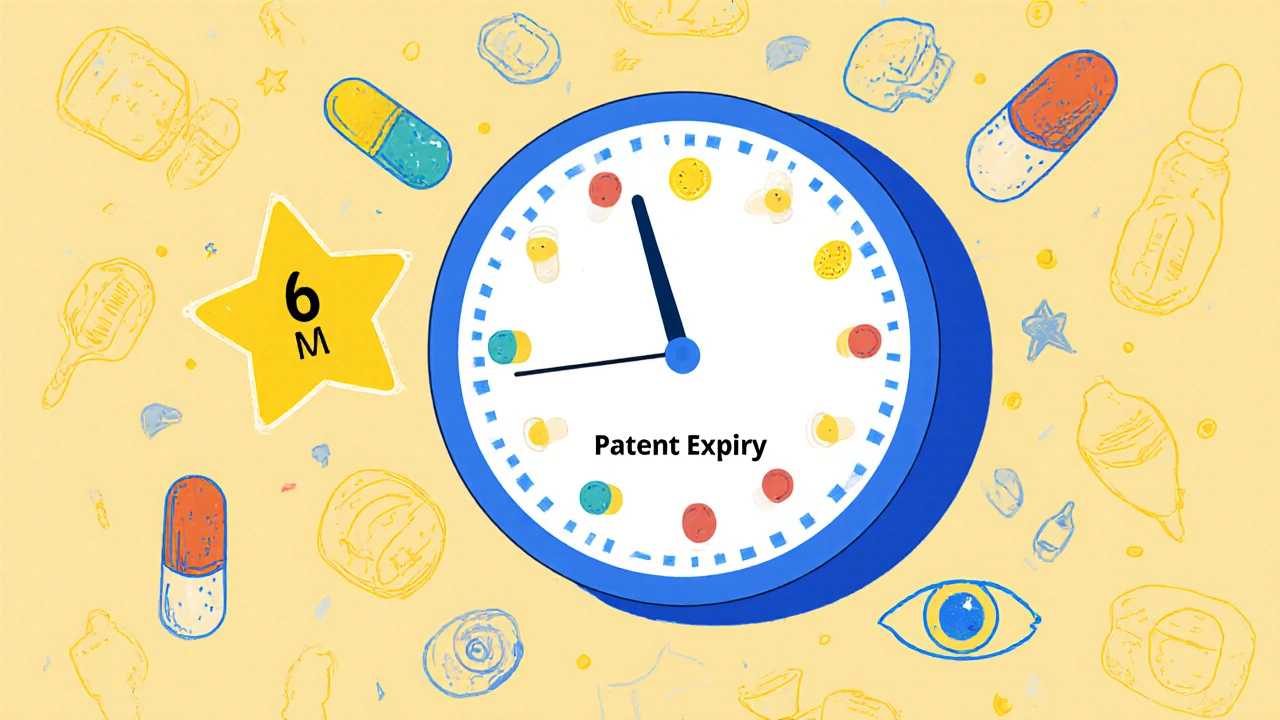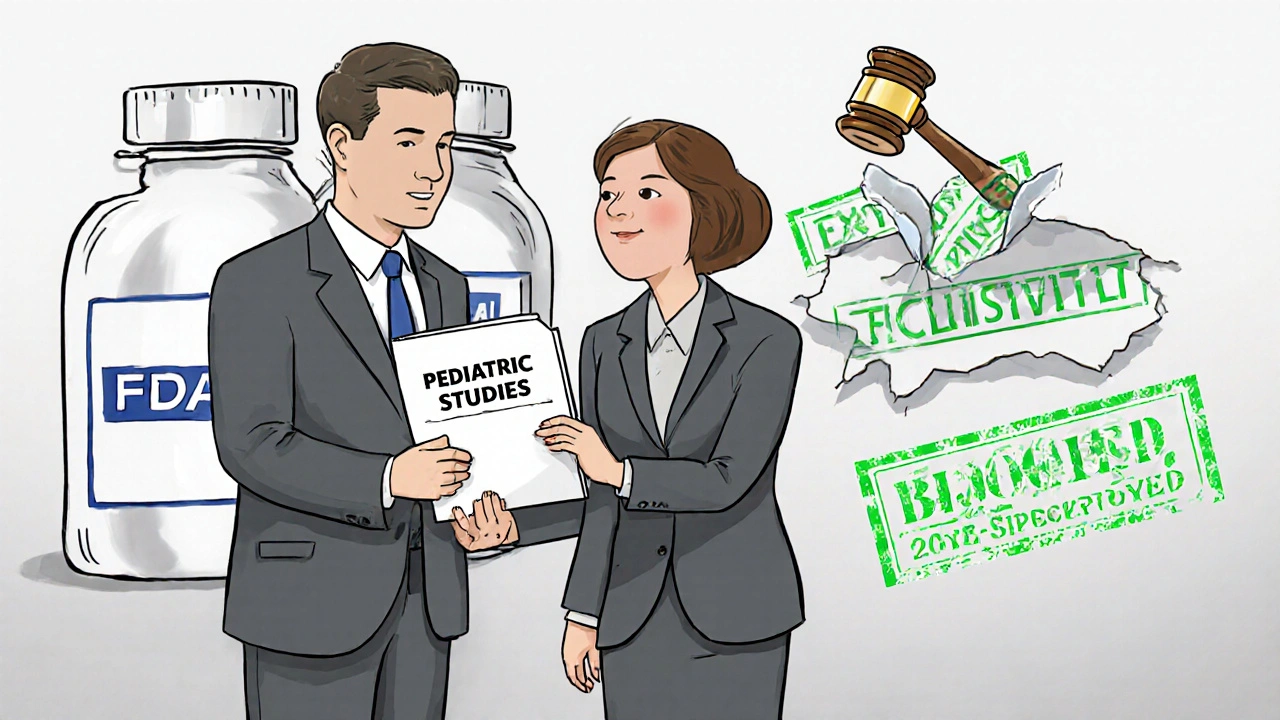Pediatric Exclusivity: How the FDA Extends Market Protection for Drugs
 Nov, 19 2025
Nov, 19 2025
When a pharmaceutical company gets approval for a new drug, it doesn’t just get a patent-it gets a clock. And that clock doesn’t tick alone. The FDA adds another layer of protection, called pediatric exclusivity, that can delay generic versions from hitting the market for six extra months. This isn’t a patent extension in the traditional sense. It doesn’t change the legal life of the patent. But it does stop the FDA from approving cheaper copies-even after the patent expires.
What pediatric exclusivity really does
Pediatric exclusivity is a reward, not a right. Companies earn it by studying their drugs in children. The FDA doesn’t force them to do it. Instead, the agency sends out a Written Request asking for specific studies on how the drug works in kids. If the company completes those studies and submits them properly, the FDA grants six months of extra market protection.
This six-month clock doesn’t just apply to the exact drug studied. It extends to every version of that drug-oral pills, liquid suspensions, creams, eye drops-anything with the same active ingredient. So if a company studies a new dose for toddlers and gets exclusivity, that same six-month delay kicks in for the adult version too.
It’s not about changing the label. It’s about blocking competitors. Even if the patent has already expired, the FDA can’t approve a generic version during this six-month window unless the generic company wins a court case proving the patent is invalid or gets permission from the original drugmaker.
How it stacks with other protections
Pediatric exclusivity doesn’t exist in a vacuum. It attaches to whatever other exclusivity the drug already has. If a drug has five-year new chemical entity (NCE) exclusivity, pediatric exclusivity tacks on six more months to that five-year period. Same with three-year exclusivity for new clinical data, or orphan drug exclusivity.
But here’s the catch: the original exclusivity must have at least nine months left when pediatric exclusivity is granted. If the drug’s protection is about to expire in eight months, the FDA won’t add the extra six. That’s a hard rule written into the law.
And it’s not just patents. Even if a drug has no patents left, pediatric exclusivity can still block generics-if the drugmaker submitted a new application to expand the drug’s use to children and that application qualified for new exclusivity. For example, if a drug was approved for adults in 2015 and had no patents left, but the company later got approval to treat children and earned three-year exclusivity for that new use, then pediatric exclusivity could attach to that new exclusivity period.
Why it’s so powerful
Think of pediatric exclusivity as a regulatory wall. Patents can be challenged in court. Generic companies can file Paragraph IV certifications claiming a patent is invalid. But pediatric exclusivity? It’s different. Courts have consistently upheld the FDA’s authority to block generic approvals during this period-even after patent expiration.
That’s why it’s called "ironclad" in industry circles. A blockbuster drug like a common asthma inhaler or ADHD medication can make hundreds of millions in sales each year. Six months of extra exclusivity could mean $300 million or more in lost generic competition. That’s why big pharma invests heavily in pediatric studies-not just to help kids, but to protect revenue.
And it’s not just about money. Before this system started, doctors often had to guess the right dose for children because there was no data. Now, thanks to these studies, labels include pediatric dosing, safety warnings, and usage instructions. It’s a win for kids and a win for companies that play by the rules.

What it doesn’t cover
Pediatric exclusivity only applies to small-molecule drugs. It doesn’t work for biologics-like insulin, monoclonal antibodies, or vaccines. That’s because biologics are regulated under a different law (the BPCIA), and the FDA doesn’t use patent linkage to block biosimilars the same way it does for generics.
Also, if a generic company successfully challenges a patent in court and wins, pediatric exclusivity can’t stop them. The FDA will approve the generic if the court rules the patent is invalid, not infringed, or unenforceable. But if the case is dropped or settled, the exclusivity stays in place.
And here’s something most people miss: pediatric exclusivity doesn’t require the drug to be labeled for children. The FDA only needs to see that the studies were done correctly and submitted properly. Even if the drug is only ever used in adults, the exclusivity still applies.
How generic companies navigate around it
Generic manufacturers have to be precise. They can’t just file an application and wait. They need to know exactly when the exclusivity ends. One day off, and their application gets rejected.
There are only four ways to get approval during the exclusivity window:
- Get a written waiver from the original drugmaker
- Win a court case proving the patent is invalid or not infringed
- Have the lawsuit against them dismissed
- Fail to be sued within 45 days of filing the application
Most of the time, generics wait. They know the clock is ticking. They track FDA filings, court dates, and patent expirations down to the day. Some even file their applications a few months early, just to be ready the moment exclusivity ends.

The bigger picture
Pediatric exclusivity was created in 1997 and made permanent in 2002. Since then, over 300 drugs have received this extension. It’s one of the most under-discussed but impactful tools in drug policy.
It’s not perfect. Some companies do studies just to get the six-month extension, without really improving care for kids. But overall, it’s led to better, safer dosing for children. And it’s become a cornerstone of how drug companies manage their product lifecycles.
For anyone following drug pricing, patent cliffs, or generic competition, pediatric exclusivity is a hidden lever. It doesn’t show up in patent databases. It’s not listed in investor reports. But it’s there-delaying generics, protecting revenue, and sometimes, saving lives.
What happens after the six months?
Once the exclusivity period ends, the FDA can approve generic versions immediately. No more delays. No more legal hurdles. The market opens up. Prices drop. And patients get access to cheaper versions of the same medicine.
But the clock doesn’t reset. There’s no second chance. If a company didn’t do the pediatric studies, they don’t get the extension. And once the six months are over, they can’t go back and ask for it later.
That’s why timing matters. The FDA gives companies a deadline to submit their studies. Miss it, and you lose the reward. It’s not a grace period. It’s a contract.
Nosipho Mbambo
November 20, 2025 AT 08:55Katie Magnus
November 21, 2025 AT 08:24King Over
November 22, 2025 AT 02:26Johannah Lavin
November 22, 2025 AT 05:50Ravinder Singh
November 23, 2025 AT 09:37Russ Bergeman
November 24, 2025 AT 01:13Dana Oralkhan
November 25, 2025 AT 19:36Jeremy Samuel
November 27, 2025 AT 02:53Destiny Annamaria
November 28, 2025 AT 04:32Liam Strachan
November 29, 2025 AT 11:37Gerald Cheruiyot
December 1, 2025 AT 00:10Michael Fessler
December 2, 2025 AT 11:05daniel lopez
December 3, 2025 AT 21:01